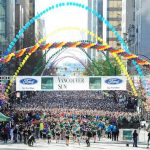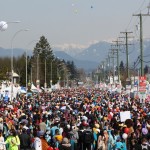Vancouver History: Greenhill Park Explosion
byThe Sinking of The Greenhill Park is one of my favourite tracks off The Matinee’s latest album We Swore We’d See the Sunrise. It’s a beautiful and haunting song with a very real — and very tragic — event behind its name. An event that took place 69 years ago (tomorrow) in Vancouver’s harbour.

March 6, 1945: S.S. “Greenhill Park” [explosion]. Photograph attributed to T. Deggs. Archives# CVA 586-3818.
Greenhill Park Explosion
“If you were here on March 6, 1945 you will remember the waterfront explosion of the 10,000-ton freighter Greenhill Park, easily the most spectacular and disastrous event in the port’s history,” wrote historian Chuck Davis in his History of Metropolitan Vancouver.
Four explosions wracked the ship and blew a gaping hole in her side. Eight longshoremen were killed, 19 other workers were injured, seven firemen ended up in hospital and hundreds of windows in downtown Vancouver, some as far west as Thurlow and as far north as Dunsmuir, were blown out.
Whole office blocks facing Burrard Inlet had scarcely a pane of glass intact. The war against Japan was in its final stages and some people thought the Japanese had begun to bomb the city.

After the explosion. Photograph attributed to Jim Fairley. Archives# CVA 1376-686.
The Vancouver Sun reported that the Grenhill Park was carrying 85 tonnes of sodium chlorate, which is a component in fertilizer but is also used in explosives. When the flames reached the sodium chlorate, it blew up. The force of which shattered windows all over downtown.


Property damage caused by the explosion. Archives# CVA 586-3598 & CVA 586-3565. Photographer: Don Coltman.
“Flames shot up 100 feet in the air as the explosions of the chemicals set off some of the ship’s ammunition,” reported The Sun. “(It) also sent ship flares soaring into the sky in an awesome display of grim fireworks.” There were about 100 men working on the ship at the time of the explosion, and eight of them were killed. It was the worst disaster in Vancouver history to that point in time. [Vancouver Sun]


Interior, after the blast. Archives# CVA 586-3617 & CVA 586-3770. Photographer: Don Coltman.
“Exploding cargo rained down from the sky for 15 minutes,” the Vancouver Maritime Museum’s records note. “Pickles fell like green hail, and sunglasses were found as far as Lumbermen’s Arch in Stanley Park.”
The Maritime Museum has a list of the ill-fated ship’s cargo on an archive of their website.
Lumber, newsprint, tin plates, pickles, cloth, sunglasses, lamps, light bulbs, books, radio equipment, and knitting needles. The destructive part of the cargo was the sodium chlorate, six tonnes of signal flares, and several barrels of “over proof” whisky. [Vancouver Sun]
A 1,500-page report released two months after the blast concluded the explosion had resulted from “improper stowage of combustible, dangerous and explosive material… and the ignition thereof by a lighted match.” That match ignited some spilled whisky, as it would later be revealed.


Damage caused by the explosion. Archives# CVA 586-3599 & CVA 586-3602. Photographer: Don Coltman.
In June of 1946 the Greenhill Park, repaired, sailed away from Vancouver as the S.S. Phaex II under the new ownership of a Greek company. By 1967, as the Lagos Michigan, she was sold to Formosan shipbreakers for scrap. [Chuck Davis‘ History of Metropolitan Vancouver]
When writing a history column for The Province in 1980, Chuck Davis received a letter from a Vancouver reader who thought it was time “the true story was known.” Accompanying the letter was a sheet of paper headed, “The True Story of the Fire and Explosion on the S.S. Greenhill Park, March 6, 1945“. You can read what Chuck discovered in his History of Metropolitan Vancouver.







